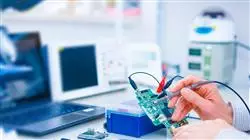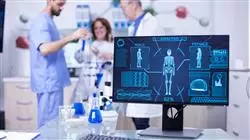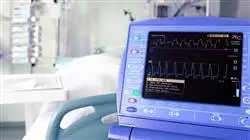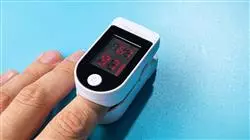University certificate
The world's largest faculty of engineering”
Introduction to the Program
Become a specialist in Biomedical Electronics and work to create the most revolutionary devices that can be used in the healthcare field with guaranteed success”

Electronics is present in nearly all areas of daily life, but if there is one where its presence is completely innovative, it is in the healthcare sector. The emergence of new and increasingly effective mechanisms has made it possible to diagnose diseases in time or to apply the latest treatments, thus improving the health of patients and increasing life expectancy. Meanwhile, investment in biomedical research and engineering is increasing, as large institutions and private companies have become aware of the importance of their development for the future of healthcare. For this reason, many engineers decide to diversify their field of action, directing their studies towards Biomedical Electronics and, for this reason, TECH has designed this program, which will enable professionals in the sector to broaden their knowledge in this field.
For this purpose, a very complete program has been structured, which includes fundamental aspects of microelectronics, analyzing the physical principles that govern the behavior of the fundamental elements of electronics; and delves into the most relevant characteristics and applications of transistors, diodes and amplifiers. Furthermore, digital processing is studied, which has experienced a vertiginous development in the last decades with the increasing implementation of devices based on digital electronics. Yet, naturally, focusing on Biomedical Electronics, addressing electrophysiology, the origin, conduction and acquisition of bioelectrical signals, as well as their filtering and amplification.
In short, a 100% online Postgraduate diploma that will allow students to manage their own study time, meaning they are not hindered by fixed schedules or the need to commute to another physical location. They can access all the contents at any time of the day, allowing them to balance their professional and personal life with their academic life.
Biomedicine requires professionals like you, capable of creating those electronic instruments that will change healthcare”
This Postgraduate diplomaa in Biomedical Electronics contains the most complete and up-to-date program on the market. The most important features include:
- Case studies presented by engineering experts
- The graphic, schematic, and practical contents with which they are created, provide scientific and practical information on the disciplines that are essential for professional practice
- Practical exercises where the self-assessment process can be carried out to improve learning
- Its special emphasis on innovative methodologies in Biomedical Electronics
- Theoretical lessons, questions to the expert, debate forums on controversial topics, and individual reflection assignments
- Content that is accessible from any fixed or portable device with an Internet connection
Open the doors to a new path full of job opportunities in the Biomedical Electronics sector”
Its teaching staff includes professionals from the field of engineering, who contribute their work experience to this program, as well as renowned specialists from leading companies and prestigious universities.
Its multimedia content, developed with the latest educational technology, will allow professionals to learn in a contextual and situated learning environment, i.e., a simulated environment that will provide immersive specialization for real situations.
This program is designed around Problem-Based Learning, whereby the student must try to solve the different professional practice situations that arise throughout the program. For this purpose, the student will be assisted by an innovative interactive video system created by renowned and experienced experts.
TECH offers you a multitude of theoretical and practical cases that will be very useful to improve your knowledge in this field"

Upon successful completion of this program, you will have acquired the necessary qualifications to enter a highly competitive industry"
Syllabus
The contents of this TECH Postgraduate diploma cover issues such as Biomedical Electronics, microelectronics or digital processing, fundamental aspects for the engineer who wishes to develop professionally in the creation and control of electronic mechanisms that can help improve people's health. A program that is organized in a structural way so that students, little by little and in a self-directed manner, can acquire the knowledge that they can later apply to their daily practice.

A program that will help you to manage yourself in a highly specialized and essential medical environment”
Module 1. Microelectronics
1.1. Microelectronics vs. Electronics
1.1.1. Analog Circuits
1.1.2. Digital Circuits
1.1.3. Signals and Waves
1.1.4. Semiconductor Materials
1.2. Semiconductor Properties
1.2.1. PN Joint Structure
1.2.2. Reverse Breakdown
1.2.2.1. Zener Breakdown
1.2.2.2. Avalanche Breakdown
1.3. Diodes
1.3.1. Ideal Diode
1.3.2. Rectifier
1.3.3. Diode Junction Characteristics
1.3.3.1. Direct Polarization Current
1.3.3.2. Inverse Polarization Current
1.3.4. Applications
1.4. Transistors
1.4.1. Structure and Physics of a Bipolar Transistor
1.4.2. Operation of a Transistor
1.4.2.1. Active Mode
1.4.2.2. Saturation Mode
1.5. MOS Field-Effect Transistors (MOSFETs)
1.5.1. Structure
1.5.2. The I-V Features
1.5.3. DC MOSFET Circuits
1.5.4. The Body Effect
1.6. Operational Amplifier
1.6.1. Ideal Amplifier
1.6.2. Settings
1.6.3. Differential Amplifiers
1.6.4. Integrators and Differentiators
1.7. Operational Amplifiers. Uses
1.7.1. Bipolar Amplifiers
1.7.2. CMOS
1.7.3. Amplifiers as Black Boxes
1.8. Frequency Response
1.8.1. Analysis of Frequency Response
1.8.2. High-Frequency Response
1.8.3. Low-Frequency Response
1.8.4. Examples
1.9. Feedback
1.9.1. General Structure of Feedback
1.9.2. Properties and Methodology of Feedback Analysis
1.9.3. Stability: Bode Method
1.9.4. Frequency Compensation
1.10. Sustainable Microelectronics and Future Trends
1.10.1. Sustainable Energy Sources
1.10.2. Bio-Compatible Sensors
1.10.3. Future Trends in Microelectronics
Module 2. Digital Processing
2.1. Discrete Systems
2.1.1. Discrete Signals
2.1.2. Stability of Discrete Systems
2.1.3. Frequency Response
2.1.4. Fourier Transform
2.1.5. The Z Transform
2.1.6. Signal Sample
2.2. Convolution and Correlation
2.2.1. Signal Correlation
2.2.2. Signal Convolution
2.2.3. Application Examples
2.3. Digital Filters
2.3.1. Classes of Digital Filters
2.3.2. Hardware Used for Digital Filters
2.3.3. Frequency Analysis
2.3.4. Effects of the Filter on the Signals
2.4. Non-Recursive Filters (FIR)
2.4.1. Non-Infinite Impulse Response
2.4.2. Linearity
2.4.3. Determination of Poles and Zeros
2.4.4. Design of FIR Filters
2.5. Recursive Filters (IIR)
2.5.1. Recursion in Filters
2.5.2. Infinite Impulse Response
2.5.3. Determination of Poles and Zeros
2.5.4. Design of IIR Filters
2.6. Signal Modulation
2.6.1. Modulation in Amplitude
2.6.2. Modulation in Frequency
2.6.3. Modulation in Phase
2.6.4. Demodulators
2.6.5. Simulators
2.7. Digital Image Processing
2.7.1. Color Theory
2.7.2. Sample and Quantification
2.7.3. Digital Processing with OpenCV
2.8. Advanced Techniques in Image Digital Processing
2.8.1. Image Recognition
2.8.2. Evolutionary Algorithms for Images
2.8.3. Image Databases
2.8.4. Machine Learning Applied to Writing
2.9. Voice Digital Processing
2.9.1. Voice Digital Processing Model
2.9.2. Representation of the Voice Signal
2.9.3. Voice Codification
2.10. Advanced Voice Processing
2.10.1. Voice Recognition
2.10.2. Speech Signal Processing for Diction
2.10.3. Digital Speech Therapy Diagnosis
Module 3. Biomedical Electronics
3.1. Biomedical Electronics
3.1.1. Biomedical Electronics
3.1.2. Characteristics of Biomedical Electronics
3.1.3. Biomedical Instrument Systems
3.1.4. Structure of a Biomedical Instrumentation System
3.2. Bioelectrical Signals
3.2.1. Origin of Bioelectrical Signals
3.2.2. Conduction
3.2.3. Potential
3.2.4. Propagation of Potentials
3.3. Bioelectrical Signal Processing
3.3.1. Bioelectrical Signal Acquisition
3.3.2. Amplification Techniques
3.3.3. Safety and Insulation
3.4. Bioelectrical Signal Filter
3.4.1. Noise
3.4.2. Noise Detection
3.4.3. Noise Filtering
3.5. Electrocardiogram
3.5.1. Cardiovascular System
3.5.1.1. Action Potentials
3.5.2. ECG Waveform Nomenclature
3.5.3. Cardiac Electric Activity
3.5.4. Electrocardiography Module Instrumentation
3.6. Electroencephalogram
3.6.1. Neurological System
3.6.2. Electrical Brain Activity
3.6.2.1. Brain Waves
3.6.3. Electroencephalography Module Instrumentation
3.7. Electromyogram
3.7.1. The Muscular System
3.7.2. Electrical Muscular Activity
3.7.3. Electromyography Module Instrumentation
3.8. Spirometry
3.8.1. Respiratory System
3.8.2. Spirometric Parameters
3.8.2.1. Interpretation of the Spirometric Test
3.8.3. Spirometry Module Instrumentation
3.9. Oximetry
3.9.1. Circulatory System
3.9.2. Operation Principle
3.9.3. Accuracy of Measurements
3.9.4. Oximetry Module Instrumentation
3.10. Electrical Safety and Regulations
3.10.1. Effects of Electric Currents on Living Things
3.10.2. Electrical Accidents
3.10.3. Electrical Safety of Electromedical Equipment
3.10.4. Classification of Electromedical Equipment

This program will open the doors to Biomedical Electronics, a field of great relevance in of great relevance in society”
Postgraduate Diploma in Biomedical Electronics.
Biomedical electronics is a branch of electronic engineering that focuses on the development of electronic devices and systems for application in medicine and biology. This area combines the principles of electronic engineering with those of biology and medicine to create technologies that can be used to improve human health and well-being.
Biomedical electronics focuses on developing devices that can be used to monitor, diagnose and treat disease. This involves creating systems that can detect and measure biological signals such as heart rate, temperature, blood pressure and muscle activity. Systems are also being developed for the delivery of therapies and drugs, such as infusion pumps and drug delivery systems.
The development of biomedical devices also involves the integration of signal and image processing techniques, as well as control and feedback algorithms to ensure accuracy and efficacy of treatment.
In addition, biomedical electronics also focuses on the development of diagnostic and monitoring systems, such as imaging systems (X-ray, magnetic resonance imaging, computed tomography, among others) and cancer detection systems. These devices enable early identification of diseases and assessment of patient health.
Biomedical electronics is a branch of electronic engineering that works on the development of electronic devices and systems for application in medicine and biology. Research in this area has led to the creation of devices and systems that can be used to monitor, diagnose and treat a wide variety of diseases and medical conditions, helping to improve human health and well-being.
The objective of this educational program is to provide students with knowledge and skills to design, develop and apply electronic technology in the field of medicine and health. Students will learn to use specialized software and hardware tools to acquire, process, visualize and analyze biomedical signals such as electroencephalograms, electrocardiograms, magnetic resonance imaging, computed tomography, among others.







